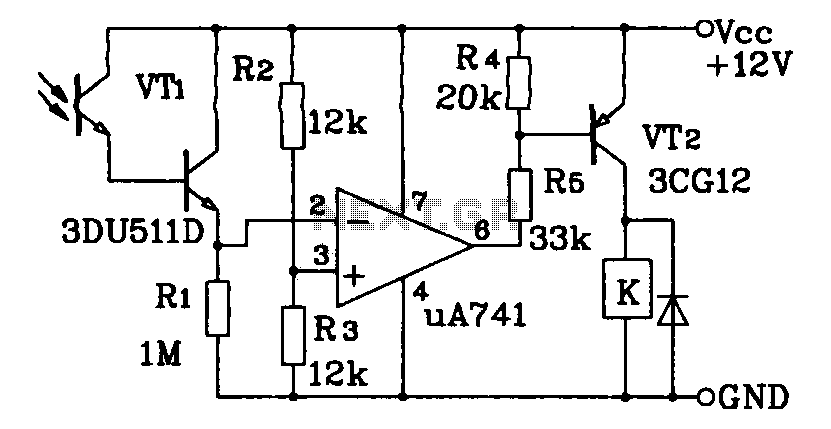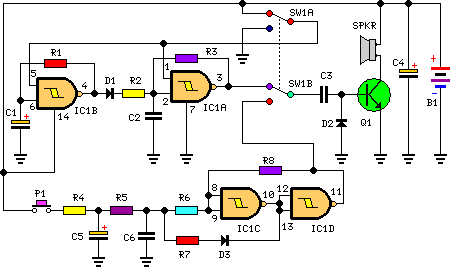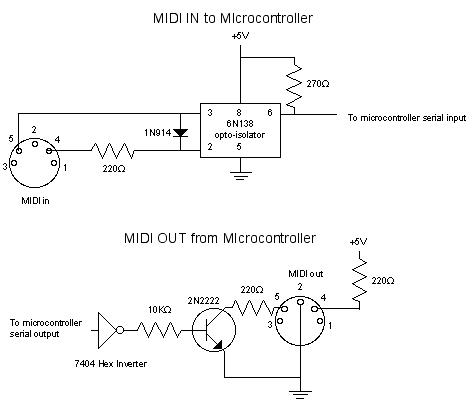
Darlington phototransistor type light-triggered circuit diagram of a switching application

This circuit application utilizes a Darlington phototransistor for light-triggered switching. The design incorporates a Darlington phototransistor and an operational amplifier (op-amp), allowing the circuit to respond to very faint light levels. The circuit can be modified to trigger in darkness by swapping the positions of R1 and the photodiodes or by reversing the inverting and non-inverting inputs of the op-amp.
The described circuit leverages the high sensitivity of a Darlington phototransistor, which is capable of amplifying weak light signals significantly. The operational amplifier serves to further enhance the signal processing, enabling the circuit to detect and respond to minimal light levels effectively.
In the standard configuration, the phototransistor is positioned to receive light, with the output connected to the op-amp configured as a comparator. The reference voltage at the non-inverting input of the op-amp is set to a level that determines the threshold for switching. When the light intensity exceeds this threshold, the op-amp outputs a high signal, activating the connected load.
For applications requiring the circuit to trigger in the absence of light, modifications can be made. By swapping the positions of R1 and the photodiodes, the circuit can be inverted. Additionally, reversing the inputs of the op-amp will alter the behavior, allowing it to activate when the light level drops below a certain point, effectively creating a dark-triggered switch.
This flexibility makes the Darlington phototransistor switching circuit suitable for various applications, including automatic lighting systems, security alarms, and light-sensitive controls. The ability to fine-tune the sensitivity and response characteristics through component selection and configuration further enhances its versatility in electronic design.Darlington phototransistor type light-triggered switching circuit application As a result of the sub-type Darlington phototransistor and the op amp, so very faint light can fli p the circuit. When the position of R1 and photodiodes swap, or op amp inverting and non-inverting input reversed position, you can put this circuit modified to trigger the opening dark.
The described circuit leverages the high sensitivity of a Darlington phototransistor, which is capable of amplifying weak light signals significantly. The operational amplifier serves to further enhance the signal processing, enabling the circuit to detect and respond to minimal light levels effectively.
In the standard configuration, the phototransistor is positioned to receive light, with the output connected to the op-amp configured as a comparator. The reference voltage at the non-inverting input of the op-amp is set to a level that determines the threshold for switching. When the light intensity exceeds this threshold, the op-amp outputs a high signal, activating the connected load.
For applications requiring the circuit to trigger in the absence of light, modifications can be made. By swapping the positions of R1 and the photodiodes, the circuit can be inverted. Additionally, reversing the inputs of the op-amp will alter the behavior, allowing it to activate when the light level drops below a certain point, effectively creating a dark-triggered switch.
This flexibility makes the Darlington phototransistor switching circuit suitable for various applications, including automatic lighting systems, security alarms, and light-sensitive controls. The ability to fine-tune the sensitivity and response characteristics through component selection and configuration further enhances its versatility in electronic design.Darlington phototransistor type light-triggered switching circuit application As a result of the sub-type Darlington phototransistor and the op amp, so very faint light can fli p the circuit. When the position of R1 and photodiodes swap, or op amp inverting and non-inverting input reversed position, you can put this circuit modified to trigger the opening dark.





